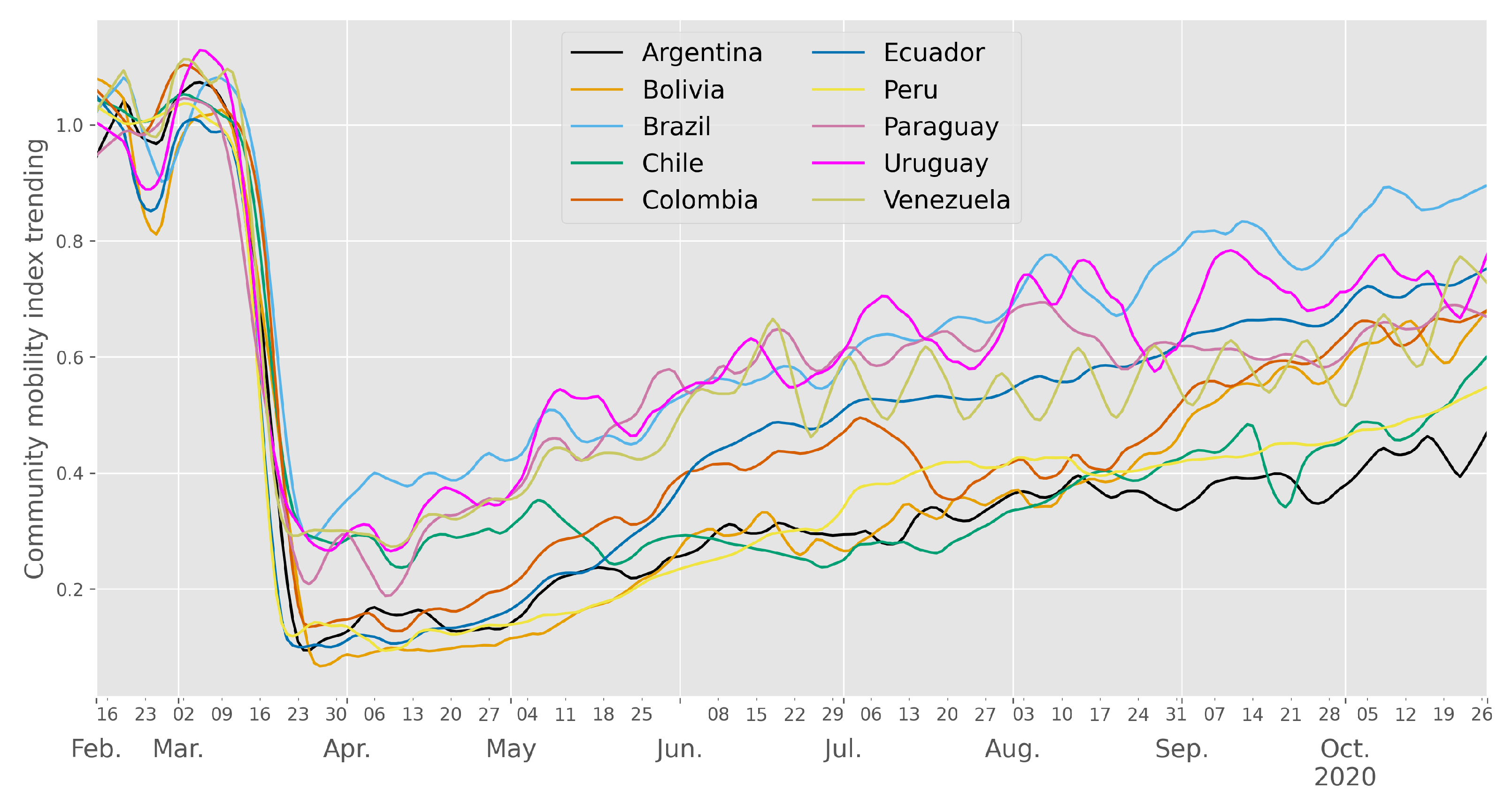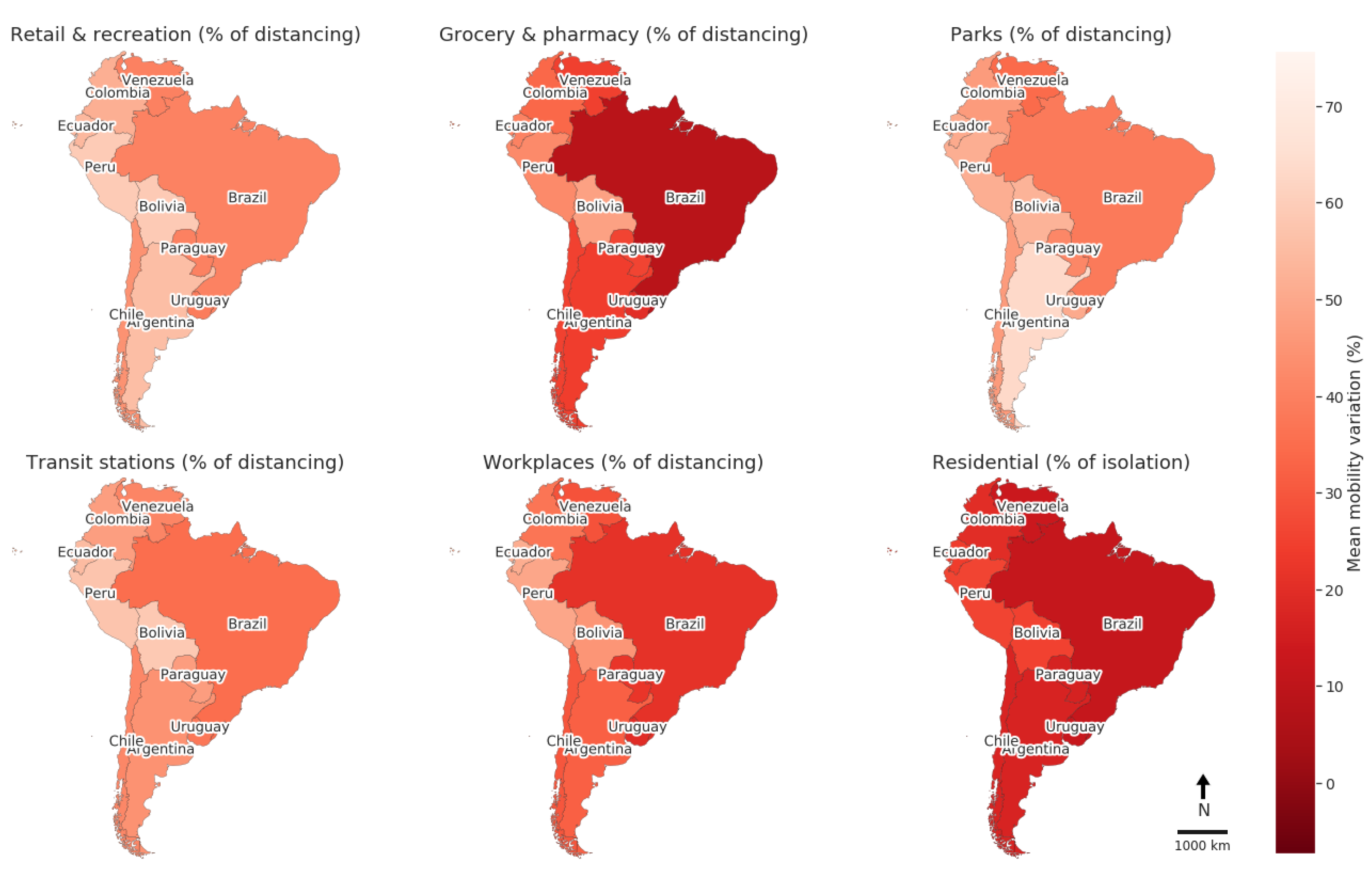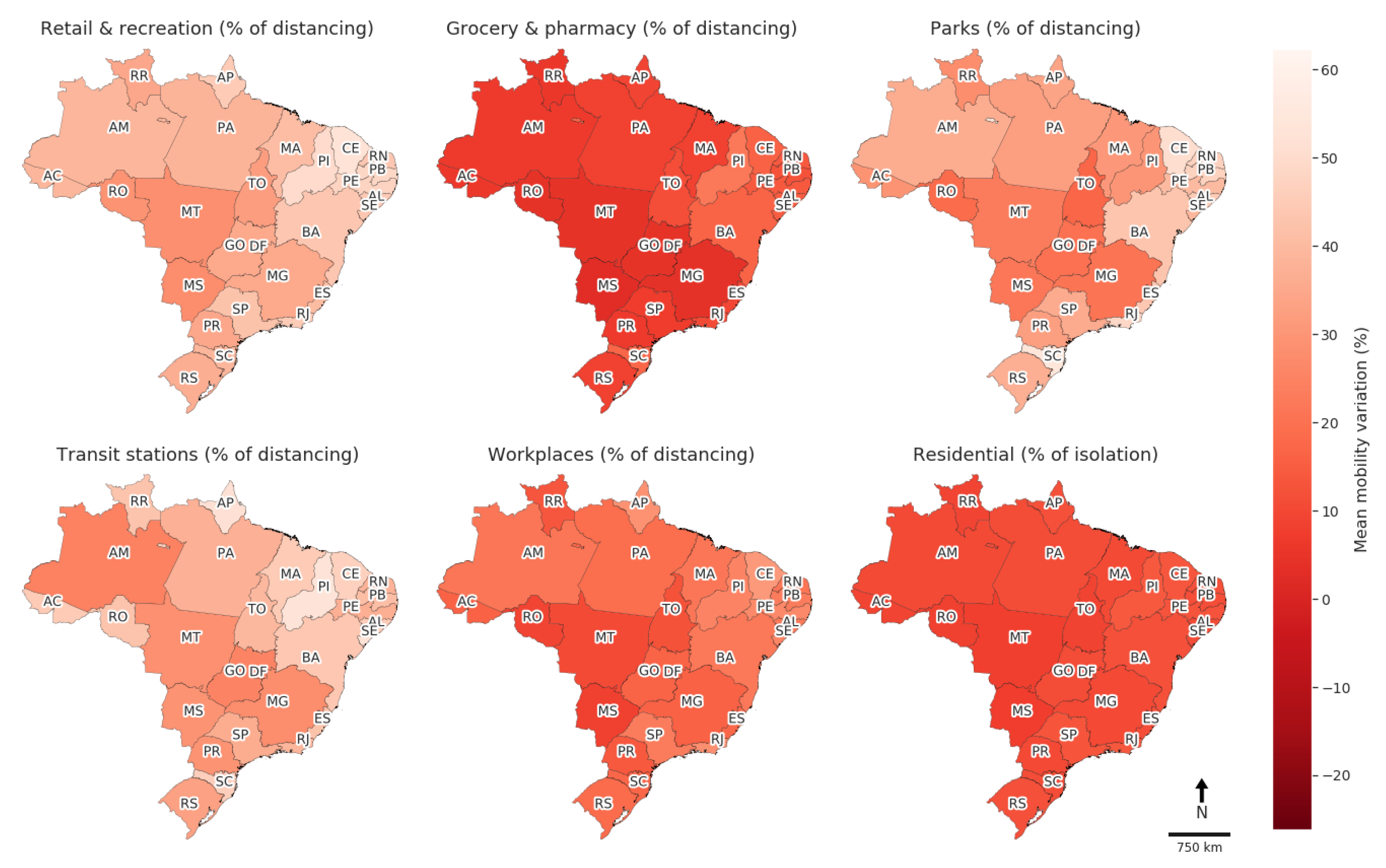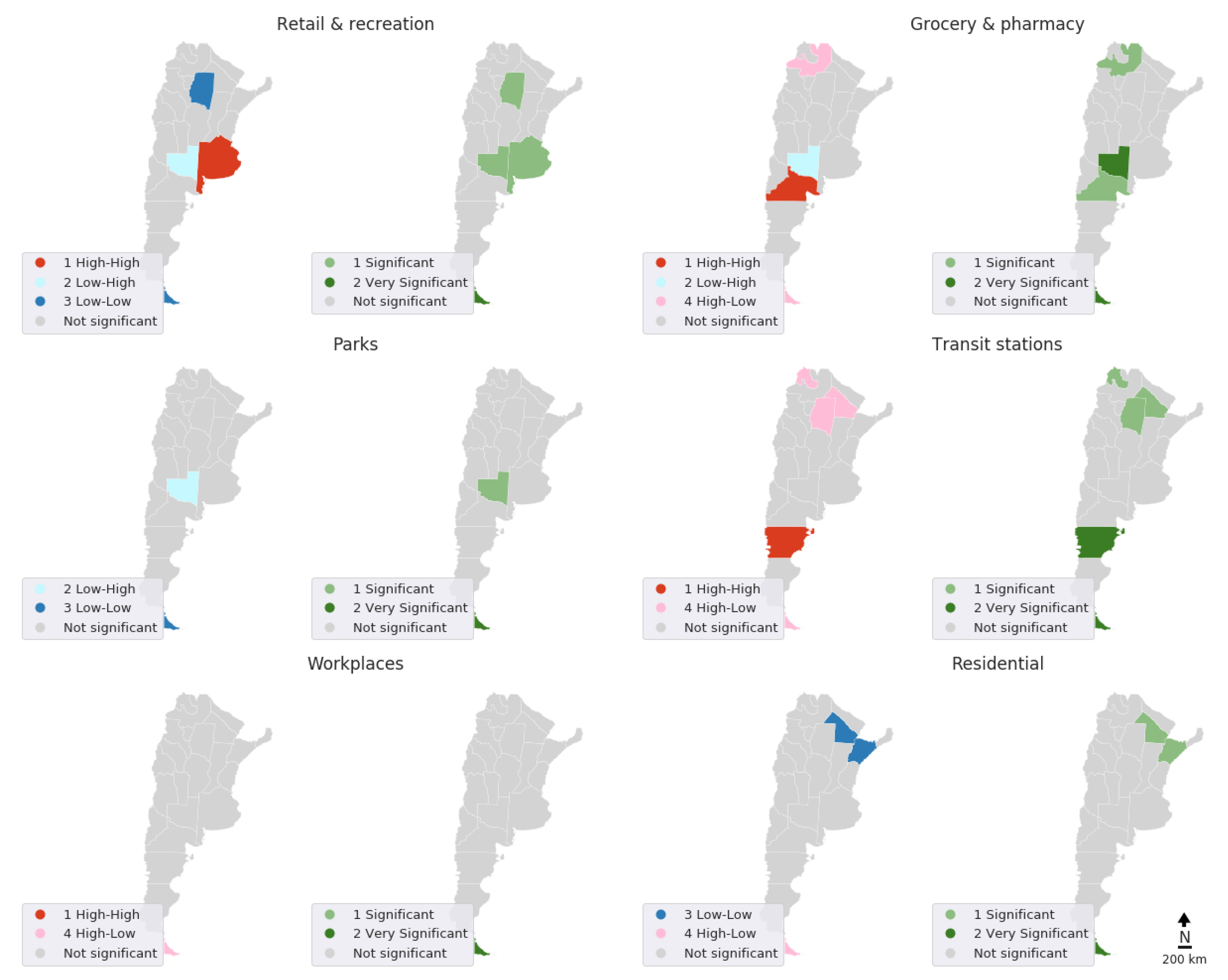Evaluating Social Distancing Measures and Their Association with the Covid-19 Pandemic in South America
Abstract
:1. Introduction
- use of data-driven approach and statistical analysis to understand the people movement during the Covid-19 pandemic and the governments’ responses in terms of social distancing measures, considering different periods and contexts in South America;
- propose the use of a measure of people movement based on Google’s geolocation data for six types of social activities, which can be compared to different geographical units, updated, and which can also be easily replicated by other researchers;
- provide objectivity to the classification of countries in South America as to the strictness level of their measures of social distancing through the use of the Covid stringency index from Oxford Covid-19 Government Response Tracker (OxCGRT), that also represents a comparable measure, with broad and free access, in addition to having daily and routinely updated information;
- using mathematical modelling, we calculate the level of transmission from Covid-19 () for countries of South America, identifying two distinct patterns of transmissibility: a transient and a steady-state period;
- relate the people movement, the strictness degree of social distancing measures and transmission levels of Covid-19 to identify patterns among the countries analysed in South America; and
- undertake a spatial analysis of mobility patterns in three specific countries in South America, and for more granular analysis units (provinces and states) than has generally been used in previous works.
2. Materials and Methods
2.1. Google Community Mobility Reports Dataset
2.2. South American Countries and Covid Stringency Index
2.3. Mobility Index
2.4. Reproduction Number
2.5. Spatial Auto-Correlation Analysis
3. Social Distancing, Easing Covid-19 Restrictions and Community Mobility in South America
4. Strictness of Social Distancing Measures and Population Mobility in South America: Is There a Pattern?
4.1. Countries with Lower Levels of Population Mobility
4.2. Countries with Higher Levels of Population Mobility
5. Mobility Pattern, Epidemiological Indicator and Public Policies to Contain the Pandemic in South America
5.1. The Scenario of the Covid-19 Crisis in Two Acts: Transient and Steady-State Periods
5.2. Lessons Learned. Implications of the Scenario for Public Policies Concerned to Covid-19
6. Spatial Analysis of the Inner Mobility Tendencies
6.1. Exploratory Analysis of Spatial Data
6.1.1. Global Moran Index
6.1.2. Local Moran Index: Clusters Formation in Argentina, Brazil, and Chile during the Pandemic
7. Discussion
- In the transient period when Covid-19 transmission levels are high and governments are implementing their first measures of social distancing, population adherence to these policies is low. Aspects, such as the population’s lower perception of risk and low level of trust in governments and authorities to deal with the pandemic, may be one of the aspects related to this pattern found;
- in the steady-state period, which corresponds to a period of greater exposure to Covid-19’s social distancing measures and more stable transmission levels, the population’s response to the rigidity of social distancing measures is not always more obedience to social distancing;
- in a more rigid scenario of measures of social distancing, few and small clusters are formed, while, in a less rigid scenario, many and extensive clusters are observed;
- the proposition of cash transfer policies and others supports for informal workers during the pandemic are important to curb population mobility, but are more likely to prosper if they are effective in their implementation and if they are accompanied by coordinated measures of social distancing and health surveillance;
- in the case of Brazil, the formation of extensive mobility clusters may have been a reflection of the absence of clear national guidelines and coordinated with the units of the federation and health authorities to face the pandemic; and
- in the case of Argentina and Chile, that represent middle-income countries in South America, the formation of clusters despite the high level of rigidity of its measures of social distancing and low level of movement of people points to the socioeconomic difficulties of these nations in maintaining only essential economic activities during the pandemic.
8. Study Limitations and Final Considerations
Author Contributions
Funding
Data Availability Statement
Acknowledgments
Conflicts of Interest
References
- World Health Organization. WHO Director-General’s Opening Remarks at the Media Briefing on COVID-19. 11 March 2020. Available online: https://www.who.int/dg/speeches/detail/who-director-general-s-opening-remarks-at-the-media-briefing-on-Covid-19---11-march-2020 (accessed on 1 August 2020).
- De Natale, G.; Ricciardi, V.; De Luca, G.; De Natale, D.; Di Meglio, G.; Ferragamo, A.; Marchitelli, V.; Piccolo, A.; Scala, A.; Somma, R.; et al. The COVID-19 Infection in Italy: A Statistical Study of an Abnormally Severe Disease. J. Clin. Med. 2020, 9, 1564. [Google Scholar] [CrossRef]
- Chahrour, M.; Assi, S.; Bejjani, M.; Nasrallah, A.A.; Salhab, H.; Fares, M.; Khachfe, H.H. A Bibliometric Analysis of COVID-19 Research Activity: A Call for Increased Output. Cureus 2020, 12, e7357. [Google Scholar] [CrossRef] [Green Version]
- Singh, R.K.; Rani, M.; Bhagavathula, A.S.; Sah, R.; Rodriguez-Morales, A.J.; Kalita, H.; Nanda, C.; Sharma, S.; Sharma, Y.D.; Rabaan, A.A.; et al. Prediction of the COVID-19 pandemic for the top 15 affected countries: Advanced autoregressive integrated moving average (ARIMA) model. JMIR Public Health Surveill. 2020, 6, e19115. [Google Scholar] [CrossRef]
- World Health Organization (WHO). Coronavirus Disease (COVID-19) Situation Report-136. 2020. Available online: https://www.who.int/docs/default-source/coronaviruse/situation-reports/20200604-covid-19-sitrep-136.pdf?sfvrsn=fd36550b_2 (accessed on 6 June 2020).
- World Health Organization. WHO Coronavirus Disease (COVID-19) Dashboard. 2020. Available online: https://covid19.who.int/ (accessed on 27 November 2020).
- Lippi, G.; Henry, B.M.; Bovo, C.; Sanchis-Gomar, F. Health risks and potential remedies during prolonged lockdowns for coronavirus disease 2019 (COVID-19). Diagnosis 2020, 7, 85–90. [Google Scholar] [CrossRef]
- The Lancet Respiratory Medicine. COVID-19: Delay, mitigate, and communicate. Lancet Respir. Med. 2020, 8, 321. [Google Scholar] [CrossRef]
- Sjödin, H.; Wilder-Smith, A.; Osman, S.; Farooq, Z.; Rocklöv, J. Only strict quarantine measures can curb the coronavirus disease (COVID-19) outbreak in Italy, 2020. Eurosurveillance 2020, 25, 2000280. [Google Scholar] [CrossRef] [PubMed]
- Aquino, E.M.; Silveira, I.H.; Pescarini, J.M.; Aquino, R.; Souza-Filho, J.A.D. Medidas de distanciamento social no controle da pandemia de COVID-19: Potenciais impactos e desafios no Brasil. Ciência Saúde Coletiva 2020, 25, 2423–2446. [Google Scholar] [CrossRef]
- Srivastava, N.; Baxi, P.; Ratho, R.; Saxena, S.K. Global Trends in Epidemiology of Coronavirus Disease 2019 (COVID-19). In Coronavirus Disease 2019 (COVID-19); Springer: Berlin/Heidelberg, Germany, 2020; pp. 9–21. [Google Scholar]
- Wong, C.K.; Wong, J.Y.; Tang, E.H.; Au, C.H.; Lau, K.T.; Wai, A.K. Effects of national containment measures on decelerating the increase in daily new cases of COVID-19 in 54 countries and four epicenters of pandemic. J. Med. Internet Res. 2020, 22, e19904. [Google Scholar] [CrossRef]
- Islam, N.; Sharp, S.J.; Chowell, G.; Shabnam, S.; Kawachi, I.; Lacey, B.; Massaro, J.M.; D’Agostino, R.B.; White, M. Physical distancing interventions and incidence of coronavirus disease 2019: Natural experiment in 149 countries. BMJ 2020, 370, m2743. [Google Scholar] [CrossRef]
- Rawson, T.; Brewer, T.; Veltcheva, D.; Huntingford, C.; Bonsall, M.B. How and when to end the COVID-19 lockdown: An optimization approach. Front. Public Health 2020, 8, 262. [Google Scholar] [CrossRef] [PubMed]
- Li, Y.; Wang, L.W.; Peng, Z.H.; Shen, H.B. Basic reproduction number and predicted trends of coronavirus disease 2019 epidemic in the mainland of China. Infect. Dis. Poverty 2020, 9, 1–13. [Google Scholar] [CrossRef] [PubMed]
- Rieger, M.O.; Wang, M. Secret Erosion of the “Lockdown”? Patterns in Daily Activities during the SARS-Cov2 Pandemics around the World. Rev. Behav. Econ. 2020, 7, 223–235. [Google Scholar] [CrossRef]
- Chowdhury, R.; Luhar, S.; Khan, N.; Choudhury, S.R.; Matin, I.; Franco, O.H. Long-term strategies to control COVID-19 in low and middle-income countries: An options overview of community-based, non-pharmacological interventions. Eur. J. Epidemiol. 2020, 35, 743–748. [Google Scholar] [CrossRef] [PubMed]
- Looi, M.K. Covid-19: Is a second wave hitting Europe? BMJ 2020, 371, m4113. [Google Scholar] [CrossRef]
- Lasry, A.; Kidder, D.; Hast, M.; Poovey, J.; Sunshine, G.; Zviedrite, N.; Ahmed, F.; Ethier, K.A. Timing of community mitigation and changes in reported COVID-19 and community mobility—four US metropolitan areas, February 26–April 1, 2020. MMWR Morb. Mortal. Wkly. Rep. 2020, 69, 451–457. [Google Scholar] [CrossRef] [Green Version]
- Vokó, Z.; Pitter, J.G. The effect of social distance measures on COVID-19 epidemics in Europe: An interrupted time series analysis. GeroScience 2020, 42, 1075–1082. [Google Scholar] [CrossRef]
- Delen, D.; Eryarsoy, E.; Davazdahemami, B. No Place Like Home: Cross-National Data Analysis of the Efficacy of Social Distancing During the COVID-19 Pandemic. JMIR Public Health Surveill. 2020, 6, e19862. [Google Scholar] [CrossRef]
- Arashi, M.; Bekker, A.; Salehi, M.; Millard, S.; Erasmus, B.; Cronje, T.; Golpaygani, M. Spatial analysis and prediction of COVID-19 spread in South Africa after lockdown. arXiv 2020, arXiv:2005.09596. [Google Scholar]
- Miller, L.E.; Bhattacharyya, R.; Miller, A.L. Spatial analysis of global variability in Covid-19 burden. Risk Manag. Healthc. Policy 2020, 13, 519. [Google Scholar] [CrossRef]
- Cruz, C.H.D.B. Social distancing in São Paulo State: Demonstrating the reduction in cases using time series analysis of deaths due to COVID-19. Rev. Bras. Epidemiol. 2020, 23, e200056. [Google Scholar] [CrossRef]
- Borracci, R.A.; Giglio, N.D. Forecasting the effect of social distancing on covid-19 autumn-winter outbreak in the metropolitan area of buenos aires. Medicina 2020, 80, 7–15. [Google Scholar]
- Pereira, I.G.; Guerin, J.M.; Junior, A.G.S.; Distante, C.; Garcia, G.S.; Goncalves, L.M. Forecasting Covid-19 dynamics in Brazil: A data driven approach. arXiv 2020, arXiv:2005.09475. [Google Scholar]
- Franch-Pardo, I.; Napoletano, B.M.; Rosete-Verges, F.; Billa, L. Spatial analysis and GIS in the study of COVID-19. A review. Sci. Total Environ. 2020, 739, 140033. [Google Scholar] [CrossRef]
- Zhu, L.; Liu, X.; Huang, H.; Avellán-Llaguno, R.D.; Lazo, M.M.L.; Gaggero, A.; Rifo, R.S.; Patiño, L.; Valencia-Avellan, M.; Diringer, B.; et al. Meteorological impact on the COVID-19 pandemic: A study across eight severely affected regions in South America. Sci. Total Environ. 2020, 744, 140881. [Google Scholar] [CrossRef]
- Hilton, J.; Keeling, M.J. Estimation of country-level basic reproductive ratios for novel Coronavirus (SARS-CoV-2/COVID-19) using synthetic contact matrices. PLoS Comput. Biol. 2020, 16, e1008031. [Google Scholar] [CrossRef]
- Oyedotun, T.D.T.; Moonsammy, S. Spatiotemporal Variation of COVID-19 and Its Spread in South America: A Rapid Assessment. Ann. Am. Assoc. Geogr. 2020, 1–12. [Google Scholar] [CrossRef]
- Huynh, T.L.D. Does culture matter social distancing under the COVID-19 pandemic? Saf. Sci. 2020, 130, 104872. [Google Scholar] [CrossRef] [PubMed]
- Borg, M.A. Cultural determinants of infection control behaviour: Understanding drivers and implementing effective change. J. Hosp. Infect. 2014, 86, 161–168. [Google Scholar] [CrossRef]
- Brito, P.L.; Kuffer, M.; Koeva, M.; Pedrassoli, J.C.; Wang, J.; Costa, F.; Freitas, A.D.D. The Spatial Dimension of COVID-19: The Potential of Earth Observation Data in Support of Slum Communities with Evidence from Brazil. ISPRS Int. J. Geo-Inf. 2020, 9, 557. [Google Scholar] [CrossRef]
- Earth Observation Data. 2020. Available online: https://earthdata.nasa.gov/earth-observation-data (accessed on 4 December 2020).
- Seale, H.; Heywood, A.E.; Leask, J.; Steel, M.; Thomas, S.; Durrheim, D.N.; Bolsewicz, K.; Kaur, R. COVID-19 is rapidly changing: Examining public perceptions and behaviors in response to this evolving pandemic. PLoS ONE 2020, 15, e0235112. [Google Scholar] [CrossRef]
- Geana, M.V. Kansans in the Middle of the Pandemic: Risk Perception, Knowledge, Compliance with Preventive Measures, and Primary Sources of Information about COVID-19. Kans. J. Med. 2020, 13, 160. [Google Scholar] [CrossRef]
- Ibuka, Y.; Chapman, G.B.; Meyers, L.A.; Li, M.; Galvani, A.P. The dynamics of risk perceptions and precautionary behavior in response to 2009 (H1N1) pandemic influenza. BMC Infect. Dis. 2010, 10, 296. [Google Scholar] [CrossRef] [Green Version]
- Taglioni, F.; Cartoux, M.; Dellagi, K.; Dalban, C.; Fianu, A.; Carrat, F.; Favier, F. The influenza A (H1N1) pandemic in Reunion Island: Knowledge, perceived risk and precautionary behaviour. BMC Infect. Dis. 2013, 13, 34. [Google Scholar] [CrossRef]
- da Câmara Ribeiro-Dantas, M.; Alves, G.; Gomes, R.B.; Bezerra, L.C.; Lima, L.; Silva, I. Dataset for country profile and mobility analysis in the assessment of COVID-19 pandemic. Data Brief 2020, 31, 105698. [Google Scholar] [CrossRef]
- Google LLC. Google COVID-19 Community Mobility Reports. 2020. Available online: https://www.google.com/covid19/mobility/ (accessed on 1 November 2020).
- Hale, T.; Webster, S.; Petherick, A.; Phillips, T.; Kira, B. Oxford covid-19 government response tracker. Blavatnik Sch. Gov. 2020, 25. [Google Scholar]
- Lima, L.C.D.; Silva, I.; Oliveira, G.L.A. Informações de Localização de Celulares Ajudam a Medir o Isolamento Social no RN. 2020. Available online: https://demografiaufrn.net/2020/04/06/informacoes-de-localizacao-de-celulares-ajudam-a-medir-o-isolamento-social-no-rn/ (accessed on 6 June 2020).
- Statsmodels. 2020. Available online: https://www.statsmodels.org/devel/generated/statsmodels.tsa.seasonal.STL.html (accessed on 4 December 2020).
- Thompson, R.; Stockwin, J.; van Gaalen, R.D.; Polonsky, J.; Kamvar, Z.; Demarsh, P.; Dahlqwist, E.; Li, S.; Miguel, E.; Jombart, T.; et al. Improved inference of time-varying reproduction numbers during infectious disease outbreaks. Epidemics 2019, 29, 100356. [Google Scholar] [CrossRef]
- Adam, D. A Guide to R-The Pandemic’s Misunderstood Metric. Nature 2020, 583, 346–348. [Google Scholar] [CrossRef]
- Du, Z.; Wang, L.; Fox, S.J.; Cowling, B.J.; Galvani, A.P.; Meyers, L.A. Proactive social distancing mitigates COVID-19 outbreaks within a month across 58 mainland China cities. medRxiv 2020. [Google Scholar] [CrossRef]
- Pei, S.; Kandula, S.; Shaman, J. Differential Effects of Intervention Timing on COVID-19 Spread in the United States. Sci. Adv. 2020, 6, eabd6370. [Google Scholar] [CrossRef]
- Cori, A.; Ferguson, N.M.; Fraser, C.; Cauchemez, S. A new framework and software to estimate time-varying reproduction numbers during epidemics. Am. J. Epidemiol. 2013, 178, 1505–1512. [Google Scholar] [CrossRef] [Green Version]
- Musa, S.S.; Zhao, S.; Wang, M.H.; Habib, A.G.; Mustapha, U.T.; He, D. Estimation of exponential growth rate and basic reproduction number of the coronavirus disease 2019 (COVID-19) in Africa. Infect. Dis. Poverty 2020, 9, 1–6. [Google Scholar] [CrossRef]
- Leclerc, Q.J.; Nightingale, E.; Abbott, S.; Jombart, T.; CMMID COVID-19 Working Group. Analysis of temporal trends in potential COVID-19 cases reported through NHS Pathways England. medRxiv 2020. [Google Scholar] [CrossRef]
- Covid-19 Estimativas de R(t) por Estados do Brasil. 2020. Available online: https://github.com/flaviovdf/Covid19 (accessed on 4 December 2020).
- The Editors of Encyclopaedia Britannica. Probability Density Function. 2018. Available online: https://www.britannica.com/science/density-function (accessed on 20 July 2020).
- World Bank. World Bank Open Data: Data for Chile, Argentina, Brazil. 2020. Available online: https://data.worldbank.org/indicator/SP.POP.TOTL (accessed on 27 November 2020).
- Shryock, H.S.; Siegel, J.S.; Larmon, E.A. The Methods and Materials of Demography; US Bureau of the Census: Suitland, MD, USA, 1973; Volume 2. [Google Scholar]
- Anselin, L.; Piras, G. Approaches towards the Identification of Patterns in Violent Events, Baghdad, Iraq; Technical Report; Arizona State Univ Tempe School Of Geographical Sciences: Tempe, AZ, USA, 2009. [Google Scholar]
- Dubé, J.; Legros, D. Spatial Econometrics Using Microdata; John Wiley & Sons: Hoboken, NJ, USA, 2014. [Google Scholar]
- Chi, G.; Zhu, J. Spatial regression models for demographic analysis. Popul. Res. Policy Rev. 2008, 27, 17–42. [Google Scholar] [CrossRef]
- Monteiro, A.M.V.; Câmara, G.; Carvalho, M.; Druck, S. Análise Espacial de Dados Geográficos; EMBRAPA: Brasília, Brazil, 2004. [Google Scholar]
- Feola, G.; Butt, A. The diffusion of grassroots innovations for sustainability in Italy and G reat B ritain: An exploratory spatial data analysis. Geogr. J. 2017, 183, 16–33. [Google Scholar] [CrossRef] [Green Version]
- Lloyd, C. Spatial Data Analysis: An Introduction for GIS Users; Oxford University Press: Oxford, UK, 2010. [Google Scholar]
- Guțoiu, G. Spatial polarization in Bucharest at the 2014 Presidential Election. S. E. Eur. J. Political Sci. 2015, III, 1–18. [Google Scholar]
- Barreca, A.; Curto, R.; Rolando, D. Assessing Social and Territorial Vulnerability on Real Estate Submarkets. Buildings 2017, 7, 94. [Google Scholar] [CrossRef] [Green Version]
- Amaral, S.; Câmara, G.; Quintanilha, J. Análise Exploratória das Relações Espaciais do Desflorestamento na Amazônia Legal Brasileira; Gisbrasil: Salvador, Brazil, 2000. [Google Scholar]
- Griffith, D.A. Spatial autocorrelation. Int. Encycl. Hum. Geogr. 2009, 2009, 308–316. [Google Scholar]
- Fontes, M.J.; Ribeiro, A.; Silva, J. Accessibility and local development: Interaction between cross-border accessibility and local development in Portugal and Spain. Procedia Soc. Behav. Sci. 2014, 111, 927–936. [Google Scholar] [CrossRef] [Green Version]
- Economic Commission for Latin America and the Caribbean (ECLAC). COVID-2019 Observatory for Latin America and the Caribbean: Actions by Country. 2020. Available online: https://eclac.maps.arcgis.com/apps/MapSeries/index.html?appid=57c96de0159641b095bd1c213c320ab9 (accessed on 3 May 2020).
- WHO Region: Region of the Americas—Argentina. 2020. Available online: https://www.who.int/countries/arg/ (accessed on 4 December 2020).
- WHO Region: Region of the Americas—Colombia. 2020. Available online: https://www.who.int/countries/col/ (accessed on 4 December 2020).
- Paniz-Mondolfi, A.E.; Sordillo, E.M.; Márquez-Colmenarez, M.C.; Delgado-Noguera, L.A.; Rodriguez-Morales, A.J. The arrival of SARS-CoV-2 in Venezuela. Lancet 2020, 395, e85–e86. [Google Scholar] [CrossRef]
- Reuters. Colombia Extends Coronavirus Lockdown Measures until July 15. 2020. Available online: https://www.reuters.com/article/us-health-coronavirus-colombia-idUSKBN23V02I (accessed on 27 November 2020).
- Agência Brasil. Chile Decreta Lockdown em Santiago Após Explosão de Casos de Covid-19. 2020. Available online: https://agenciabrasil.ebc.com.br/saude/noticia/2020-05/chile-decreta-lockdown-em-santiago-apos-explosao-de-casos-de-covid-19 (accessed on 27 November 2020).
- Peru: WHO Coronavirus Disease (COVID-19) Dashboard | WHO Coronavirus Disease (COVID-19) Dashboard. 2020. Available online: https://covid19.who.int/region/amro/country/pe (accessed on 27 November 2020).
- Hallo, A.; Rojas, A.; Hallo, C. Perspective from Ecuador, the Second Country with More Confirmed Cases of Coronavirus Disease 2019 in South America: A Review. Cureus 2020, 12, e7452. [Google Scholar] [CrossRef] [Green Version]
- EL COMERCIO. ¿Cómo Funcionan las Restricciones de Movilidad en Quito, Frente al Covid-19? 2020. Available online: https://www.elcomercio.com/actualidad/restricciones-movilidad-excepcion-quito.html (accessed on 6 June 2020).
- World Bank. World Bank Open Data: Population, Total. 2020. Available online: https://data.worldbank.org/?locations=CL-AR-BR (accessed on 27 November 2020).
- Lancet, T. COVID-19 in Brazil: “So what?”. Lancet 2020, 395, 1461. [Google Scholar] [CrossRef]
- Ajzenman, N.; Cavalcanti, T.; Da Mata, D. More than Words: Leaders’ Speech and Risky Behavior during a Pandemic. 2020. Available online: https://ssrn.com/abstract=3582908 (accessed on 15 September 2020).
- Uruguay: WHO Coronavirus Disease (COVID-19) Dashboard | WHO Coronavirus Disease (COVID-19) Dashboard. 2020. Available online: https://covid19.who.int/region/amro/country/uy (accessed on 27 November 2020).
- World Health Organization. COVID-19 Weekly Epidemiological Update, 3 November 2020; Technical Documents; World Health Organization: Geneva, Switzerland, 2020. [Google Scholar]
- Taylor, L. Uruguay is winning against covid-19. This is how. BMJ 2020, 370, m3575. [Google Scholar] [CrossRef]
- Paraguay: WHO Coronavirus Disease (COVID-19) Dashboard | WHO Coronavirus Disease (COVID-19) Dashboard. 2020. Available online: https://covid19.who.int/region/amro/country/py (accessed on 27 November 2020).
- Paniz-Mondolfi, A.; Munoz, M.; Florez, C.; Gomez, S.; Rico, A.; Pardo, L.; Barros, E.C.; Hernandez, C.; Delgado, L.; Jaimes, J.E.; et al. SARS-CoV-2 spread across the Colombian-Venezuelan border. Infect. Genet. Evol. 2020, 86, 104616. [Google Scholar] [CrossRef] [PubMed]
- Venezuela (Bolivarian Republic of): WHO Coronavirus Disease (COVID-19) Dashboard | WHO Coronavirus Disease (COVID-19) Dashboard. 2020. Available online: https://covid19.who.int/region/amro/country/ve (accessed on 27 November 2020).
- Hummel, C.; Knaul, F.M.; Touchton, M.; Guachalla, V.X.V.; Nelson-Nuñez, J.; Boulding, C. Poverty, precarious work, and the COVID-19 pandemic: Lessons from Bolivia. Lancet Glob. Health 2021. [Google Scholar] [CrossRef]
- de Carvalho, C.A.; Viola, P.C.D.A.F.; Sperandio, N. How is Brazil facing the crisis of Food and Nutrition Security during the COVID-19 pandemic? Public Health Nutr. 2021, 24, 561–564. [Google Scholar] [CrossRef]
- Prates, I.; Barbosa, R.J. The Impact of COVID-19 in Brazil: Labour Market and Social Protection Responses. Indian J. Labour Econ. 2020, 63, 31–35. [Google Scholar] [CrossRef]
- UNICEF-Argentina. Survey on People’s Perceptions and Attitudes. Impact of COVID-19 Pandemic and Government Measures on Everyday Lives. 2020. Available online: https://www.unicef.org/argentina/ (accessed on 20 February 2021).
- Fetzer, T.; Witte, M.; Hensel, L.; Jachimowicz, J.; Haushofer, J.; Ivchenko, A.; Caria, S.; Reutskaja, E.; Roth, C.; Fiorin, S.; et al. Perceptions of an Insufficient Government Response at the Onset of the COVID-19 Pandemic are Associated with Lower Mental Well-Being. PsyArXiv. [CrossRef]
- Peru, Panama Limit Movement By Gender In Bid To Slow The Coronavirus. 2020. Available online: https://www.npr.org/sections/coronavirus-live-updates/2020/04/03/826604070/peru-panama-limit-movement-by-gender-in-bid-to-slow-the-coronavirus (accessed on 27 November 2020).
- Mariani, L.; Gagete-Miranda, J.; Retti, P. Words can hurt: How political communication can change the pace of an epidemic. Covid Econ. Vetted Real Time Pap. 2020, 12, 104–137. [Google Scholar] [CrossRef]























| Country | Informal Employment (%) | Gini Index |
|---|---|---|
| Uruguay | 24.0 | 39.7 |
| Argentina | 49.4 | 41.4 |
| Bolivia | 84.9 | 42.2 |
| Peru | 68.4 | 42.8 |
| Chile 2 | 29.2 | 44.4 |
| Ecuador | 73.6 | 45.4 |
| Paraguay | 68.9 | 46.2 |
| Colombia | 62.1 | 50.4 |
| Brazil | 47.9 | 53.9 |
| 15 February to 31 May 2020 | 1 June to 27 October 2020 | ||||
|---|---|---|---|---|---|
| Region | Place | Moran’s I | p-Value | Moran’s I | p-Value |
| Argentina | Retail & recreation | 0.2390 | 0.0530 | 0.2845 | 0.0110 |
| Grocery & pharmacy | 0.1329 | 0.1180 | 0.2066 | 0.0640 | |
| Parks | 0.2047 | 0.0540 | 0.0070 | 0.3450 | |
| Transit stations | −0.0696 | 0.4260 | −0.1798 | 0.1790 | |
| Workplaces | 0.3333 | 0.0070 | 0.4041 | 0.0030 | |
| Residential | 0.4007 | 0.0050 | 0.3459 | 0.0090 | |
| Brazil | Retail & recreation | 0.5414 | 0.0010 | 0.5581 | 0.0010 |
| Grocery & pharmacy | 0.5501 | 0.0010 | 0.4030 | 0.0030 | |
| Parks | 0.3538 | 0.0070 | 0.5184 | 0.0010 | |
| Transit stations | 0.2132 | 0.0440 | −0.0085 | 0.3610 | |
| Workplaces | 0.2956 | 0.0130 | 0.4581 | 0.0010 | |
| Residential | 0.2926 | 0.0190 | 0.1412 | 0.0850 | |
| Chile | Retail & recreation | 0.0640 | 0.3260 | 0.3620 | 0.0470 |
| Grocery & pharmacy | −0.3320 | 0.1680 | −0.0319 | 0.4390 | |
| Parks | 0.2866 | 0.0850 | 0.3494 | 0.0520 | |
| Transit stations | 0.0612 | 0.3020 | 0.1141 | 0.2310 | |
| Workplaces | −0.2710 | 0.1750 | −0.1849 | 0.3350 | |
| Residential | 0.0907 | 0.2110 | −0.0050 | 0.4100 | |
Publisher’s Note: MDPI stays neutral with regard to jurisdictional claims in published maps and institutional affiliations. |
© 2021 by the authors. Licensee MDPI, Basel, Switzerland. This article is an open access article distributed under the terms and conditions of the Creative Commons Attribution (CC BY) license (http://creativecommons.org/licenses/by/4.0/).
Share and Cite
Oliveira, G.L.A.d.; Lima, L.; Silva, I.; Ribeiro-Dantas, M.d.C.; Monteiro, K.H.; Endo, P.T. Evaluating Social Distancing Measures and Their Association with the Covid-19 Pandemic in South America. ISPRS Int. J. Geo-Inf. 2021, 10, 121. https://doi.org/10.3390/ijgi10030121
Oliveira GLAd, Lima L, Silva I, Ribeiro-Dantas MdC, Monteiro KH, Endo PT. Evaluating Social Distancing Measures and Their Association with the Covid-19 Pandemic in South America. ISPRS International Journal of Geo-Information. 2021; 10(3):121. https://doi.org/10.3390/ijgi10030121
Chicago/Turabian StyleOliveira, Gisliany Lillian Alves de, Luciana Lima, Ivanovitch Silva, Marcel da Câmara Ribeiro-Dantas, Kayo Henrique Monteiro, and Patricia Takako Endo. 2021. "Evaluating Social Distancing Measures and Their Association with the Covid-19 Pandemic in South America" ISPRS International Journal of Geo-Information 10, no. 3: 121. https://doi.org/10.3390/ijgi10030121
APA StyleOliveira, G. L. A. d., Lima, L., Silva, I., Ribeiro-Dantas, M. d. C., Monteiro, K. H., & Endo, P. T. (2021). Evaluating Social Distancing Measures and Their Association with the Covid-19 Pandemic in South America. ISPRS International Journal of Geo-Information, 10(3), 121. https://doi.org/10.3390/ijgi10030121











